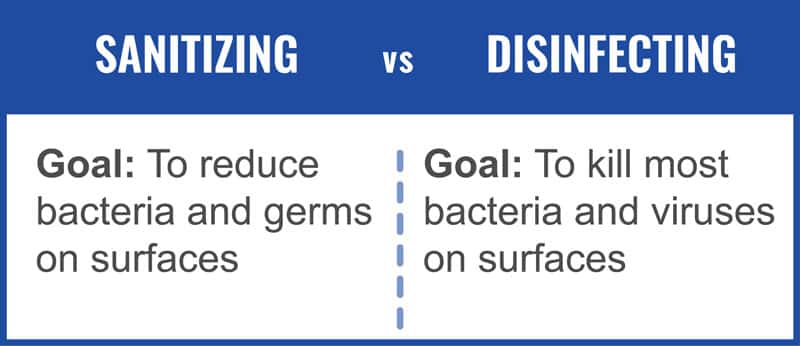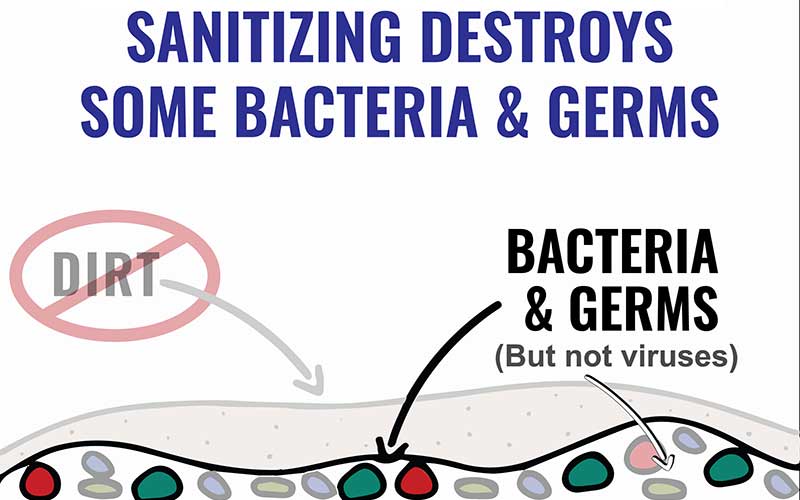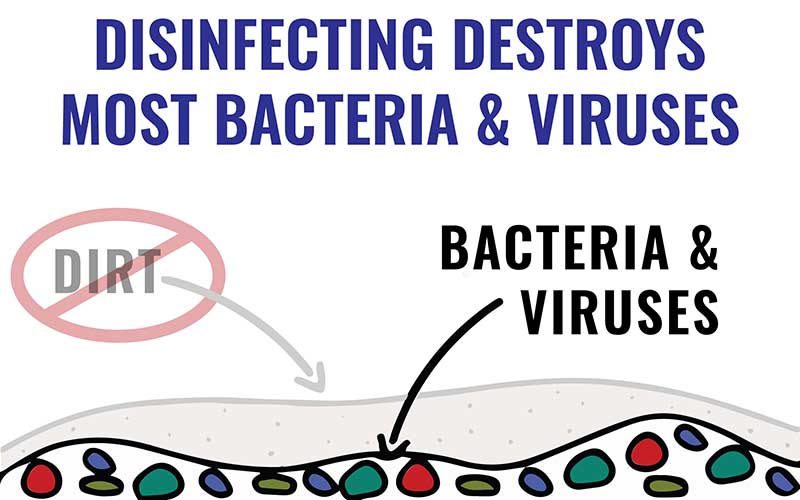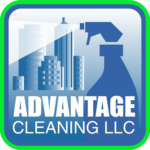These days with the COVID-19 virus, the words “sanitize” and “disinfect” are frequently being used together and seemingly interchangeably. How do you know which one is right; sanitize vs disinfect?
It’s easy to see why there is confusion about the difference between these two activities or processes. However, disinfecting and sanitizing are different, do different things and are used for different purposes. In this article we are going to cover the difference between sanitize and disinfect.
The main reason why they are used interchangeably and may get confused with each other is because sanitizing and disinfecting have important similarities that we will cover shortly. However they have purposes and have different outcomes. Let’s cover these purposes and outcomes now to show the difference.
Defining Sanitize vs Disinfect
Sanitization is meant to kill germs. Sanitizing is to reduce bacteria on a surface. This reduction can range from 99.9% (Non-Food Contact) to 99.999% (Food Contact) of common germs that dwell on surfaces in 30 seconds. To sanitize something requires chemicals that can kill microorganisms.
Disinfection is meant to inactivate (kill) disease-causing microorganisms. It destroys bacteria viruses and fungi. To do this successfully, the chemicals must dwell on a surface for 10 minutes or longer which is much longer than a sanitizer.

Sanitize vs Disinfect: The Similarities
- They both kill microorganisms – Sanitizing and disinfecting both have the goal of killing harmful microorganisms that are on surfaces. Sanitizing for bacteria and disinfectant for viruses.
- They both require a clean surface – In order for both sanitizing and disinfecting to be as effective as possible, the surface must be cleaned first. These chemicals can only destroy a percentage of organisms so physically removing bacteria particles from a surface reduces the number of microorganisms the chemical has to kill.
- They have harmful chemicals – Chemicals that can kill microorganisms are inherently dangerous to all living things, including humans.
Sanitize vs Disinfect: The Differences


The killing capability is different:
Disinfecting kills almost all microorganisms including the hardest to kill viruses, depending on the level of disinfection.
Sanitizing only kills germs and bacteria.
Here is a chart showing the differences in numbers of microorganisms that are killed between the two.

Sanitizing is more diluted compared to disinfecting.
Sanitizers are regulated by the FDA – which means that the chemicals in sanitizers are safe to enter the human body to some degree and must be tested to ensure that they will not harm humans. Just like any other consumable products and ingredients.
Situations involving human skin, food, items that touch food like dishes or cooking tools, should be sanitized rather than disinfected and if they must be disinfected, the chemicals must be completely washed off and removed from the surface before it can be used again.
Conversely, disinfectants are regulated by the EPA (Environmental protection Agency) because they are dangerous enough to harm the environment and must be tested to ensure their capabilities & risks. EPA-registered surface disinfectants, including surface wipes, should not be applied on your skin or ingested. Here’s a great article explaining “Why aren’t hand sanitizers listed on List N?” of the EPA’s disinfectants.
So When Do I Sanitize vs Disinfect?
Let’s follow these steps of thinking to figure out this answer.
- The first step will always be to clean a surface with soap and water, regardless of whether it’s sanitizing vs disinfecting.
- This cleaning process will handle most needs for most areas, most of the time and should be done frequently to protect against bacteria issues.
- Remember that cleaning with soap and water is the best solution for the physical removal of foreign (dust, soil) and organic (blood, secretions, excretions, microorganisms) materials.
- When you should sanitize:
- Areas that are involved with food, food preparation and food consumption. You should also sanitize
- Places that have high risk of collecting bacteria such as high touch surfaces (door knobs, phones, light switches, etc)
- If your facility receives high traffic volumes (offices with many visitors)
- If there is no access to soap and water to wash hands, hand sanitizer is
- When you should disinfect:
- If high levels bacteria are present such as fecal matter or bodily fluids.
- If there is a viral illness present.
- Common places that require frequent disinfection are restrooms, hospitals, medical offices and schools.
Get Started
Now that you know the difference between sanitizing and disinfecting, you need to decide when to use each one. Sanitizing is used before cleaning or before handling food to prevent the spread of bacteria. Disinfecting is used after cleaning to kill any remaining bacteria. If you would like help with Commercial Disinfection Services of your facility in New York, New Jersey or Connecticut, please contact us.



